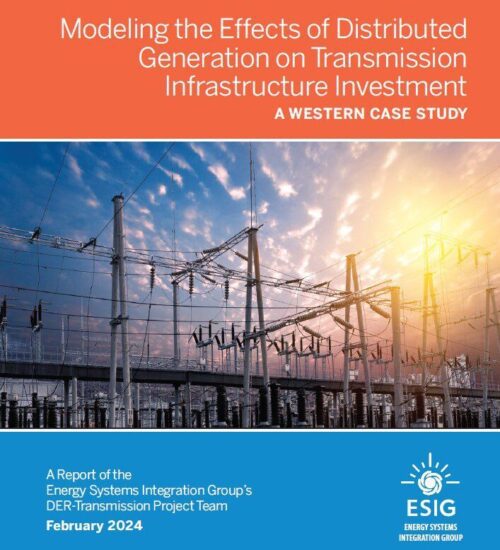New ESIG Report: Modeling the Effects of Distributed Generation on Transmission Infrastructure Investment: A Western Case Study

A STUDY EXAMINING DIFFERENCES IN TRANSMISSION NEEDS WHEN MEETING CLEAN ENERGY GOALS WITH HIGHER LEVELS OF UTILITY-SCALE RESOURCES VERSUS DISTRIBUTED RESOURCES
Reston, Va. – The Energy Systems Integration Group (ESIG) has released a new report, Modeling the Effects of Distributed Generation on Transmission Infrastructure Investment: A Western Case Study, modeling the impacts that increasing distributed generation deployments may have on transmission flows and transmission investments.
The increasing adoption of distributed generation technologies has the potential to transform the way we plan and operate energy systems. But while there is some understanding of the relationship between distributed generation and the distribution system, the impact of distributed generation on high-voltage bulk transmission systems—connecting major cities, planning areas, and states—has received much less attention.
This study looked at the Western Interconnection to explore how increasing distributed generation deployments may impact zonal transmission flows and the need for transmission investment. It also investigated potential synergies between transmission and resource expansion. Three scenarios representing different long-term capacity expansion decisions were modeled: a centralized scenario held distributed generation at current levels while selecting utility-scale generation, a hybrid scenario held distributed generation at double current levels while selecting utility-scale generation, and a distributed scenario simulated distributed generation resources.
“This study examines the difference in transmission when meeting clean energy goals with higher levels of utility-scale versus distributed resources,” said Debra Lew, associate director of the Energy Systems Integration Group. “At moderate levels, distributed generation and storage offsets some transmission but at high levels they can cause the need for much more transmission and storage.”
This study demonstrates that the need for transmission investment is sensitive to the manner in which distributed generation and batteries are adopted. Keegan Moyer, study lead, said that “by demonstrating how different penetration levels of distributed generation can change flow and congestion patterns across macro-scale transmission, the study highlights the inescapable trade-offs between flexible generation, storage, and transmission to meet future system needs. While distributed generation and storage demonstrates the potential to delay the need for certain transmission investments, a future that relies too heavily on distributed generation and storage may require higher investments in storage and transmission. This report is yet another data point calling for an “all of the above” approach to resource and transmission planning as diversity continues to present itself as the optimal path forward.”
ESIG is a nonprofit organization that marshals the expertise of the electricity industry’s technical community to support grid transformation and energy systems integration and operation. The report can be downloaded at https://www.esig.energy/distributed-generation-impact-on-transmission/.


